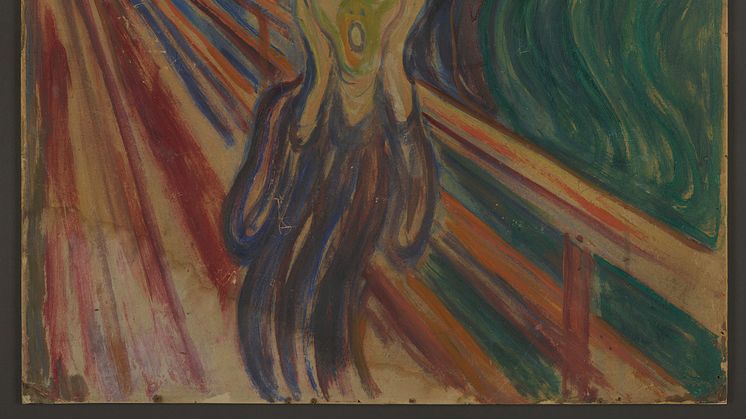
Press release -
MUNCH TØYEN REOPENS WITH NEW EXHIBITION PROGRAM AND DIGITAL STUDIO
Experience two brand new exhibitions when MUNCH Tøyen reopens for visitors June 15. Visitors will experience the photo exhibition The Experimental Self as well as Yonder: Edvard Munch and Nature. To those who cannot visit physically, MUNCH will continue to spread Edvard Munch’s art through digital channels from a pop up studio set-up within the exhibition.
"The Experimental Self"
Edvard Munch was among the first artists in history to take self-portraits or “selfies.” Like his paintings, prints and writings, his amateur photographs are often about self-representation. Munch assumes a range of personalities, from the vulnerable patient at the clinic to the naked artist on the beach. Sometimes he staged himself and people around him almost theatrically. Munch pursued his informal photography as an experimental medium, just like his paintings and prints. The artist himself was more than often the experimental subject.
Munch took up photography in 1902, months before he and his lover Tulla Larsen ended a multi-year relationship with a pistol shot that mutilated one of his fingers. This event, and an accelerating career, triggered a period of increasing emotional turmoil that culminated in a rest cure in the private Copenhagen clinic of Dr. Daniel Jacobson in 1908–09. After a break of almost two decades, Munch picked up the camera again in 1927. This second period of activity lasted into the mid-1930s and was bracketed by triumphant retrospective exhibitions in Berlin and Oslo but also by a hemorrhage in his right eye, temporarily impairing his vision. This was also the time that Munch tried his hand at home movies.
Unlike his prints and paintings, however, Munch did not exhibit his tiny, copy-printed photographs. Yet he wrote in 1930, “I have an old camera with which I have taken countless pictures of myself, often with amazing results … Some day when I am old, and I have nothing better to do than write my autobiography, all my self-portraits will see the light of day again.”
The exhibition is curated by Patricia Berman and originally produced by The American Scandinavian Foundation/Scandinavia House, New York in collaboration with the Munchmuseet. The exhibition will showcase 60 photographs and movie fragments.
See a selection of high resolution images her
"Yonder: Edvard Munch and Nature":
Edvard Munch painted nature throughout his life, and used it deliberately to depict the transition between the inner and the outer world.
The exhibition presents world-famous paintings such as The Scream and The Sun, as well as lesser known paintings that have never been exhibited before. The exhibition is divided into two parts in order to demonstrate the breadth of Munch’s paintings of nature, from his darker and more symbolic paintings, to his lighter and more energetic motifs. Here we find enchanted forests, light summer nights and silent winter landscapes, but also sunlit summer motifs full of vivid colours and naked bathers. The title of the exhibition plays on movements between inner and outer landscapes, between the inward-looking and the outward-looking.
See a selection of images her
To reach art lovers who cannot travel to MUNCH, both from within Norway and from abroad, MUNCH offers a special MUNCH Studio within the exhibition. From here MUNCH will broadcast artists’ conversations, music and workshops through its digital channels.
Opens from 10 am -4 pm
Visit Munchmuseet.no for more information
FACTS ABOUT NEW MUNCH
- One of the world's largest museums dedicated to one artist.
- 11 exhibition halls are spread over 7 floors
- The museum's collection consists of 45 000 works of art and objects that are being moved from the old to the new museum building
- Over 220 Munch works will be on display at all times in the new museum
- Gross area: 26 313 m2
- The building was designed by the Spanish architectural firm Estudio Herreros.
- The museum is one of 50 role models in the Future Built program, the Oslo region's prestigious program consisting of buildings of high architectural quality and a 50% reduction in greenhouse gas emissions in transport, energy use and material use compared to similar buildings.
TIMELINE
- 2008: Resolution passed by Oslo City Council to build Munchmuseet in Bjørvika
- 2009: Estudio Herreros’ design ‘Lambda’ wins the architectural competition
- 2010: Munchmuseet becomes an autonomous municipal agency, incorporating the former Stenersen Museum
- 2011: The building project is discontinued
- 2014: Resolution passed by Oslo City Council to construct ‘Lambda’
- 2016: Laying of the building’s foundation stone
- 2019: The building’s façade is completed
- 2020: Opening
MUNCH is home to the world's largest collection of works by Norwegian artist Edvard Munch. In Autumn 2020, MUNCH will open in a brand new building on Oslo’s waterfront. The bespoke structure, designed by estudio Herreros, will house more than 26,000 works that Edvard Munch bequeathed to the City of Oslo. The museum also manages collections donated by Rolf Stenersen, Amaldus Nielsen and Ludvig Ravensberg.
The new museum will trace the artist’s profound influence both on modern art and on artists through to the present day. Alongside displays of iconic artworks from the renowned permanent collection, temporary exhibitions will show Edvard Munch’s lasting influence in his own contemporary society, as well as on today’s generation of artists.
Visitors will experience the highlights of Edvard Munch’s oeuvre, in parallel with a wide-ranging programme of cultural events and experiences for visitors of all ages. From its location in Bjørvika, with unparalleled views of the Oslo Fjord, the museum will offer an extensive program of art and cultural experiences across thirteen floors.
